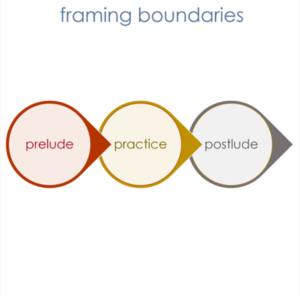In a multiple-slide post on my Instagram feed, I talked about neuroplasticity, the science of change (and, um, how things can stay the same) in a 10-frame post. But that doesn’t lend itself well to this format, so here’s the text for you.
Neuroplasticity refers to the role of the brain and nervous system (which includes the autonomic + enteric nervous systems) in helping create change. In this post, I’d like to apply that very cool science to the art + practice of setting good interpersonal + intrapersonal boundaries.
Emerging research suggests that we can target a behavior we’d like to strengthen (or extinguish) by focusing not just on the practice itself, but on the prelude and postlude that precede and follow it. This helps recruit our attentional centers to pay attention. It supercharges our motivational system. And it deepens the relationship we have with the behavior we want to nourish. Here’s what that looks like in graphic form:

Prelude. In the prelude, we focus on how the need for a boundary feels in our mind, brain, and body. Does an alarm response register in our autonomic and enteric nervous system? Or in the form of inflammation in our immune system, emotional body, or connective tissue matrix? For this phase, interoception (mindful awareness of body sensations) is critical.
We can employ the Embodied Check-In or a “boundary invasion detection” practice. The key thing is to do these regularly over time to know whether an interpersonal or intrapersonal boundary issue is in play. “Intrapsychic” means that something internal or historical, unrelated to someone else, is giving us the sense of boundary violation, and whether internal (but also relational) work is warranted.
Practices in the Prelude phase include: sensing levels of nervous system activation (we need activation to detect a boundary invasion); vagal tone stimulation (contrary to popular belief, this isn’t a “rest-and-digest” thing, it’s promoting a state of active calm; focusing our attention; connective tissue work; restorative yoga; and avoiding conceptual and language-based analysis of bodily states. (The “what” beats the “why” here.)
Practice. In the Practice phase, we focus on setting boundaries in and with our body. A boundary that remains purely conceptual doesn’t feel real to us or to others. Embodied boundaries signal that we mean business.
In this phase, just as we want to connect with and establish boundaries, we may end up seeking or receiving information about the needs and desires of others. This can be a blessing; it helps us learn to differentiate others’ needs and desires from our own. This is, as it happens, an intrapsychic boundary that acts as a foundation for an interpersonal one.
In the Practice phase, practices can include: the Embodied Check-In to mitigate focus on others’ needs and inner states; allowance of greater nervous system arousal; proprioception, including optic flow; cultivating body agency; promoting vagal tone (active calm); some boundary rehearsal (but make it embodied); and anticipating how it will feel as you set the boundary, which mobilizes your dopamine (motivation) system. This isn’t a one and done thing, but rather, a place you might return to as you prepare to set the boundary.
Postlude. The Postlude, or third phase of the neuroplasticity of setting boundary, is rich with opportunity. Here, we often experience post-boundary emotional fallout: Sometimes directed at us by someone who wishes we hadn’t set limits (but at the same time, is learning from us how to do so). At other times, the residue originates inside us. We can experience fear of abandonment or retribution. We can encounter guilt or shame. We can feel adrift without the social and emotional currency of being accommodating so others value us.
In the Postlude phase, we learn to really feel and be with the emotional fallout and residue. Where is it located in our mind, brain, and body?
Here again, the Embodied Check-In is critical. Often, connective tissue work helps release some of the residue, so we can inquire into what “abides” now. Restorative yoga, the body scan, or yoga nidra are great for boundary skill consolidation (and post-execution practice). Dynamic rest practices are great here. In this phase, we can mobilize our rest-and-digest system to restore equilibrium.
Social Context. Like neuroplasticity, boundaries are a social construct; as such, they include our respect for other people’s limits. Do we honor and protect the boundaries of marginalized folks and those with less privilege? Can we take action against the infringement of borders—and bodies—by dominant social groups and nations?
In the end, an evolved boundary practice is evidenced not only in its amalgam of strength and stability. It is also marked by its flexibility and expansiveness, and the extent to which we practice through the lens of our larger social body.